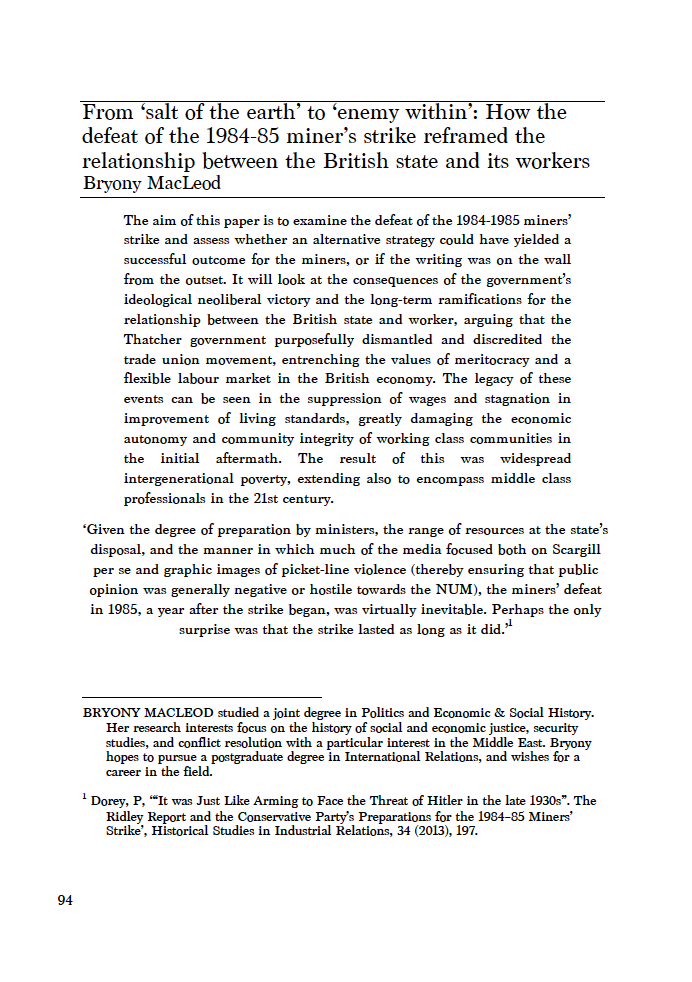From ‘salt of the earth’ to ‘enemy within’
How the defeat of the 1984-85 miner’s strike reframed the relationship between the British state and its workers
DOI:
https://doi.org/10.36399/GroundingsUG.10.190Keywords:
Miners' Strike, British Mining, 1984-1985, Workers' rights, Thatcher, DeindustrialisationAbstract
The aim of this paper is to examine the defeat of the 1984-1985 miners’ strike and assess whether an alternative strategy could have yielded a successful outcome for the miners, or if the writing was on the wall from the outset. It will look at the consequences of the government’s ideological neoliberal victory and the long-term ramifications for the relationship between the British state and worker, arguing that the Thatcher government purposefully dismantled and discredited the trade union movement, entrenching the values of meritocracy and a flexible labour market in the British economy. The legacy of these events can be seen in the suppression of wages and stagnation in improvement of living standards, greatly damaging the economic autonomy and community integrity of working class communities in the initial aftermath. The result of this was widespread intergenerational poverty, extending also to encompass middle class professionals in the 21st century.
References
Ackers, P, ‘Gramsci at the Miners’ Strike: Remembering the 1984-1985 Eurocommunist Alternative Industrial Relations Strategy’, Labour History, 55.2 (2014), 151-72.
Amos, D, ‘The Nottinghamshire miners, the Union of Democratic Mineworkers and the 1984-85 miners’ strike: scabs or scapegoats?’ PhD thesis, University of Nottingham. (2012), pp. 1-376.
Arnold, J. (2016). "The Death of Sympathy." Coal Mining, Workplace Hazards, and the Politics of Risk in Britain, ca. 1970-1990. Historical Social Research / Historische Sozialforschung, 41(1 (155)), 91-110.
Bradley, H ‘No More Heroes? Reflections on the 20th anniversary of the miners’ strike and the culture of opposition’, Work, Employment and Society, 22.2 (2008), 337-49.
Brotherstone, T and Pirani, S, ‘Were There Alternatives? Movements from Below in the Scottish Coalfield, the Communist Party, and Thatcherism, 1981-1985’, Critique: Journal of Socialist Theory, 36-7 (2005), 99-124.
Buckley, S. B, ‘The state, the police and the judiciary in the miners’ strike: Observations and discussions, thirty years on’, Capital & Class, vol. 39, (2015), pp. 419-434.
Conservative Party, The Conservative Party Manifesto 2017, https://www.conservatives.com/manifesto.
Denman, J, ‘Unemployment statistics from 1881 to the present day’, (Office of National Statistics,1996).
Dorey, P, ‘“It was Just Like Arming to Face the Threat of Hitler in the late 1930s”. The Ridley Report and the Conservative Party’s Preparations for the 1984–85 Miners’ Strike’, Historical Studies in Industrial Relations, 34 (2013), 173–214.
Dorey, P. ‘The Stepping Stones Programme: The Conservative Party’s Struggle to Develop a Trade Union Policy, 1975-1979’ Historical Studies in Industrial Relations (HSIR) 31/32 (2011), pp.115–54.
Freeman, R and Pelletier, J, ‘The Impact of Industrial Relations Legislation on British Union Density, British Journal of Industrial Relations, Vol. 28(2), (1990), pp.141-164.
Griffin, C, ‘“Notts. have some very peculiar history”: Understanding the Reaction of the Nottinghamshire Miners to the 1984–85 Strike’, Historical Studies in Industrial Relations 19 (2005), 63–99.
Hart, Christopher. "Metaphor and intertextuality in media framings of the (1984–1985) British Miners’ Strike: A multimodal analysis." Discourse & Communication 11.1 (2017): 3-30.
Howell, D ‘Defiant Dominoes: Working Miners and the 1984–5 Strike’, in Ben Jackson and Robert Saunders, eds, Making Thatcher’s Britain (Cambridge University Press), (2012), 148–64.
Jones, O, ‘Jeremy Hunt’s battle with junior doctors is his miners’ strike moment’, The Guardian, (2016), https://www.theguardian.com/commentisfree/2016/apr/26/jeremy-hunt-crush-junior-doctors-miners-strike.
Joseph, K and Strauss, N, ‘Stepping Stones Report’, Margaret Thatcher Foundation, http://www.margaretthatcher.org/document/111771.
Kelliher, ‘Solidarity and Sexuality: Lesbians and Gays Support the Miners, 1984–5’,History Workshop Journal, 77.1 (2014), 240-62.
Labour Party. The Labour Party Manifesto 2017. Labour Party, 2017, http://www.labour.org.uk/index.php/manifesto2017.
Leeworthy, D, ‘The secret life of us: 1984, the miners’ strike and the place of biography in writing history “from below”’, European Review of History, 19.5 (2012), 825-46.
Philips, J, ‘Contested memories: The Scottish parliament and the 1984–5 miners’ strike’, Scottish Affairs 24.2 (2015): 187–206.
Philips, J, ‘The Miner’s Strike in Britain, 1984-85’, Campaigning for change: can we learn from history?, Friends of the Earth, (2016), pp. 143-153.
Phillips, J, ‘Containing, Isolating and Defeating the Miners: the UK Cabinet Ministerial Group on Coal and the three phases of the 1984–5 Strike’, Historical Studies in Industrial Relations, 35 (2014), 117-41.
Ridley, R, ‘Report of Nationalised Industries Policy Group (leaked Ridley report)’, Margaret Thatcher Foundation, http://www.margaretthatcher.org/document/110795.
Samuel, R, Bloomfield, B and Boanas, G, ‘Enemy Within: Pit Villages and the Miners' Strike of 1984 85’, History Workshop Series, Routledge, (1987).
Saville, J, ‘An Open Conspiracy: Conservative Politics and the Miners’ Strike, 1984–5’, The Socialist Register, 22 (1985–86), 295–329.
Stanton, Richard, et al. "Who’s next? Cuts to welfare often target immigrants first but then move to nationals." British Politics and Policy at LSE (2016).
Turner, R, ‘Post-War Pit Closures: The Politics of De-Industrialisation’, Political Quarterly, 56.2 (April 1985), 167-74.
UK Government, ‘Historical coal data: coal production, availability and consumption 1853 to 2015’, Department for Business, Energy & Industrial Strategy, (2016).
Wallington, P, ‘Policing the Miners’ Strike’, Industrial Law Journal, Vol. 14 (1985) 145-159.

Downloads
Published
Issue
Section
License
Copyright (c) 2017 Bryony MacLeod

This work is licensed under a Creative Commons Attribution 4.0 International License.
The CC BY 4.0 license is a Creative Commons license. This is a non-copyleft free license that is good for art and entertainment works, and educational works. It is compatible with all versions of the GNU GPL; however, like all CC licenses, it should not be used on software. People are free to: Share — copy and redistribute the material in any medium or format; Adapt — remix, transform, and build upon the material for any purpose, even commercially. The licensor cannot revoke these freedoms as long as you follow the license terms. But they must conform to the following terms: Attribution — You must give appropriate credit, provide a link to the license, and indicate if changes were made. You may do so in any reasonable manner, but not in any way that suggests the licensor endorses you or your use. No additional restrictions — You may not apply legal terms or technological measures that legally restrict others from doing anything the license permits.
Please check individual article PDF copies to see if any additional restrictions apply.







